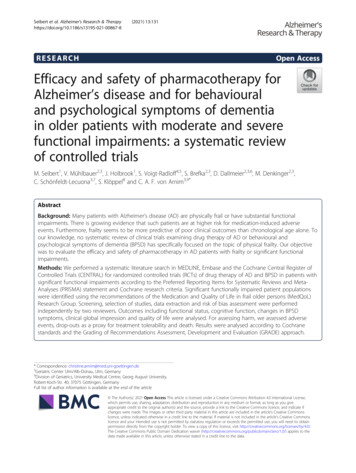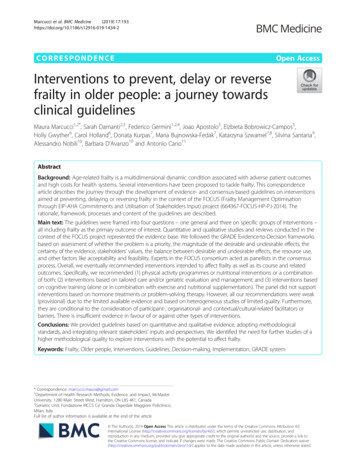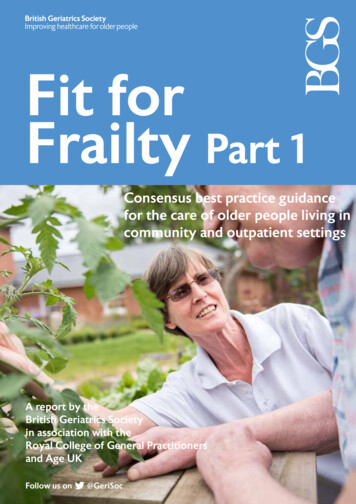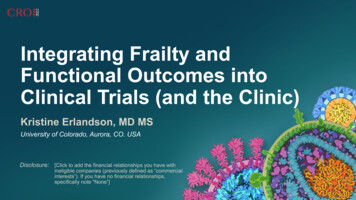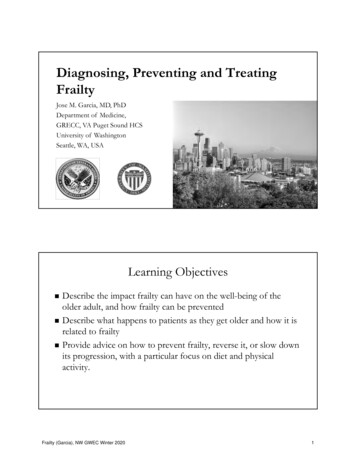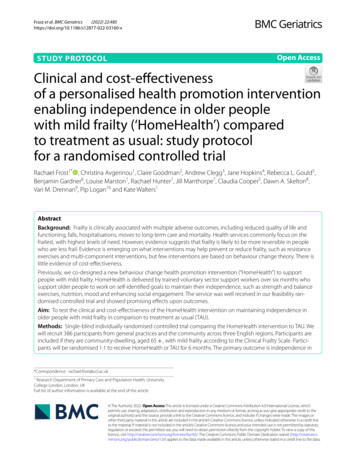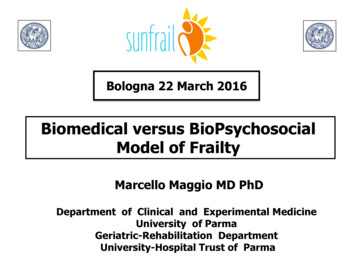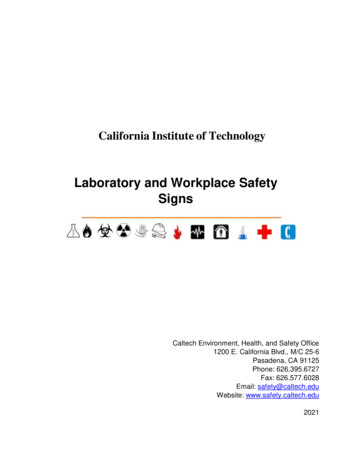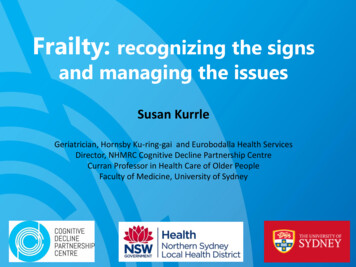
Transcription
Frailty: recognizing the signsand managing the issuesSusan KurrleGeriatrician, Hornsby Ku-ring-gai and Eurobodalla Health ServicesDirector, NHMRC Cognitive Decline Partnership CentreCurran Professor in Health Care of Older PeopleFaculty of Medicine, University of Sydney
Life expectancy in Australia:Men 81 yearsWomen 85 years2
What is frailty?
4
5
6
7
88
Definition of Frailty 1:Physical phenotypeOperationally defined as:“A clinical syndrome in which three or more of thefollowing are present: unintentional weight loss ( 4.5kgs in last year) self-reported exhaustion weakness (grip strength) slow walking speed low physical activity”9Fried et al. Frailty in older adults: evidence for a phenotype. J Geront2001;56:M146-M156
FRAIL scale10Morley 2012
Definition of Frailty 2:Accumulated deficits model Biological process 11“Accumulated deficits”Gender specificClearly related to mortalityExpressed as an “index”Mitnitski, Rockwood et al. The mortality rate as a function of accumulated deficits ina frailty index. Mechanisms of Ageing and Development 123 (2002) 1457 - 1460
Frailty Index12
13
14Definition of frailty 3:Multidimensional model of frailty Frailty is a dynamic state affecting an individual whoexperiences losses in one or more domains of humanfunctioning (physical, psychological, social), which is causedby the influence of a range of variables and which increasesthe risk of adverse outcomes14
1515
16Consequences of frailty Approx 21% people over age 65 are frail, 48% are pre-frail Frailty is associated with: 16increased likelihood of hospitalisationlonger length of hospital stayincreased risk of functional declineincreased risk of institutionalisationincreased risk of deathincreased risk of falls: Prefrail 1.5 times risk of falls Frail 2.5 – 3 times risk of falls Due to: sarcopaenia and subsequent muscle weakness with reducedphysical performance (2 – 3 times more likely to fall) Multiple medications Multiple comorbidities
17What is sarcopaenia? Age related loss of muscle, associated with decreased musclefunction Lose 1% per year of muscle from age 30, more after 75 Biggest loss is from gluteal muscles Sarcopaenia is treatable with exercise and protein supplementation Sarcopaenia is a major contributor to frailty and falls17
18Treatment of frailty There are generally considered to be four evidencebased areas of intervention for older people with frailty: Physical exercise (particularly resistance training)Nutritional interventions (protein supplementation)Multicomponent interventionsIndividualised geriatric care Frailty Intervention Trial (FIT): RCT of 241 community dwelling people aged 70yrs and over,assessed as frail using Fried Frailty criteria (3 or more criteria) Randomised to intervention (mainly exercise – WEBBexercises, and nutritional advice) or control (normal care) Blinded follow-up at 3 and 12 months looking at frailty(number of Fried frailty criteria) and physical performance(SPPB)18Cameron 2013
191
FIT Program Results20
Case Mrs T: start of intervention21Fried criteria - “frail” – Walking speed, Exhaustion, Grip,Energy expenditure
Case Mrs T: end of intervention22No longer “frail” – only grip strength
23
Frailty Clinical Practice GuidelinesRecommendations: Strong: Use a validated measurement tool to identify frailty Prescribe physical activity with a resistance training component Address polypharmacy Conditional Screen for, and address, fatigue Address weight loss with protein/calorie supplementation ifappropriate Prescribe Vit D if Vit D deficient24JAMDA Dent 2017
Where to next for frailty? In hospital: Assess using FRAIL scale Identify using eMR based assessment tool Intervene with physiotherapy, dietetics, pharmacy In outpatient setting: Frailty clinics with nursing, allied health, medical input Pre-op clinics to assess for pre-habilitation In general practice: Assess using FRAIL scale Routine assessment of sit to stand ability Referral for case management of frailty with allied health input (includingpharmacy) depending on results of FRAIL scale25
Northern Sydney Frailty InitiativePrimary Health Network and Local Health District workingtogether to address frailty in the Northern Sydney region26 Northern Sydney has an ageing population. Approx 25% people aged 70 and over are frail, in NorthernSydney there are likely to be 26,000 frail older people Screening (with FRAIL Scale) and interventions occurring inacute hospital wards 150 patients screened with referralsmade to physiotherapist, dietitian, and pharmacist asindicated with Management Tool Screening (with FRAIL Scale) occurring in general practice inOver 75 assessment, and at other consultations, with referralsmade as appropriate using Management Tool
FRAIL ScaleQuestionFatigueHow much of the time during the past 4 weeks did you feel tired?A All or most of the timeB Some, a little or none of the timeScoringRResistanceIn the last 4 weeks by yourself and not using aids, do you have any difficulty walking up 10 steps without resting?Yes 1No 0AAmbulationIn the last 4 weeks by yourself and not using aids, do you have any difficulty walking 300 meters?FIYes 1No 0IllnessDid your Doctor ever tell you that you have? LA 1B 0HypertensionDiabetesCancer (not a minor skin cancer)Chronic lung diseaseHeart AttackCongestive heart failureAnginaAsthmaArthritisStrokeKidney disease0–4answers 05 – 11answers 1Loss of weightHave you lost more than 5kg or 5% of your body weight in the past year?Yes 1No 0Total Score27Scoring: Robust 0, Pre-frail 1-2, Frail 3Result
Frailty Management Tool- AcuteAssessment ScoreFRAIL scale 0 robustIntervention Encourage ongoing activity levels Provide “Staying Active and on yourfeet” and “Eating Well” resourceFRAIL scale 1-2 pre-frailFRAIL scale 3 frailIf Frailty Score is positive address underlying causes as outlined belowFeeling fatigued most or Consider screening for reversiblecauses of fatigue (sleep apnoea,depression, anaemia, hypotension,hypothyroidism, B12 deficiency) Consider referring to an individualisedprogressive exercise program withresistance and strength component Review indication, side effects and useof medicationConsider discussing with pharmacistConsider reducing/de-prescribingsuperfluous medication Pharmacist for comprehensive medication reviewelectronic referral via emr; Choose ‘pharmacy consult’, Reason: “other”,order comment write “FRAIL”Consider screening for reversiblecauses of weight loss and considerProtein and CaloricSupplementation/Food FortificationAdvice and encourage Healthy Eating;provide “Eating Well” resource Dietician for diet review and managementelectronic referral via eMR, Inpt Dietitian Consult. Choose ‘other’ reason,text write “FRAIL”all of the timeResistance againstReferral /Follow upProvide Example of exercises in Staying Active and On Your Feet booklet NSW exercise venues: www.activeandhealthy.nsw.gov.augravity - Difficultywalking up 10 stepswithout restingNotify treating teamPhysiotherapy for exercise prescriptionelectronic referral via emr; Choose ‘blank’ reason, text write ”FRAIL”Ambulation-Difficultywalking 300 metersunaidedHaving 5 or moreIllnesses Loss of 5kg weight in 12months 28
Frailty Management Tool- Primary CareAssessment ScoreFRAIL scale 0 robustIntervention Encourage ongoing activity levelsProvide “Staying Active and on your feet” and “Eating Well”resourceReferral /Follow up If Frailty Score is positive address underlying causes as suggested belowFRAIL scale 1-2 Pre-frail Consider screening for reversible causes of fatigue (sleep apnoea,FRAIL scale 3 Fraildepression, anaemia, hypotension, hypothyroidism, B12Feeling fatigued most or all of thedeficiency)time Use EPWORTH scale, K10 or Geriatric Depression scale in HealthResistance against gravity Difficulty walking up 10 stepswithout resting Assessment Consider referring to an individualised progressive exerciseprogram with resistance and strength component Ambulation-Difficulty walking300 meters unaided Having 5 or more Illnesses Loss of 5% weight in 12 months 29Review indication, side effects and use of medication (evidence foruse of some medicines changes after age 75!)Consider discussing with pharmacistConsider reducing/de-prescribing superfluous medicationConsider screening for reversible causes of weight loss andconsiderProtein and Caloric Supplementation/Food Fortification (75mgprotein per day required- range of products available at pharmacy)Advice and encourage Healthy Eating; provide “Eating Well”resource Re-do FRAIL scale in 12 monthsCommunity exercise with balance/resistance component includingNSLHD Stepping On and Healthy Lifestyle classes.Example of exercises in Staying Active and On Your Feet bookletand NSW exercise venues: www.activeandhealthy.nsw.gov.auConsider referral to Geriatrician /Specialist for complex carepatientsConsider referral to Occupational Therapy for functional and homereviewConsider referral Psychologist using Mental Health Care PlanConsider referral to Aged Care organisation for loneliness support(isolation can be a cause of fatigue!)Physiotherapy or Exercise Physiologist for exercise prescriptionIf has diabetes- group session Medicare funded ex. physiologistHealthy Lifestyle for group exercise prescription and/or SteppingOnGet Healthy for free telephone-based health coachingNSHNS Safe and Steady programPhysiotherapy or Exercise Physiologist for exercise prescriptionHealthy Lifestyle for group exercise prescription and/or SteppingOnGet Healthy for free telephone-based health coachingExercise options https://www.activeandhealthy.nsw.gov.auPharmacist for comprehensive medication review,(HMR item 900)Occupational Therapy for functional, home and cognitive reviewSelf-management support from aged care org volunteerWeigh and asses BMI – record in patient recordDietician for diet review and managementAdd SustagenMeal Delivery ServicesSpeech pathologist for swallowing reviewDentist for dental review (pain/infection/ill fitting dentures)Occupational Therapy for functional and home cooking abilityreview
Frailty grams/frailty/30
31FRAIL Scale testing site: parc.net.au31
Questions?32
9 Definition of Frailty 1: Physical phenotype Operationally defined as: "A clinical syndrome in which three or more of the following are present: unintentional weight loss ( 4.5kgs in last year) self-reported exhaustion weakness (grip strength) slow walking speed low physical activity" Fried et al. Frailty in older adults: evidence for a phenotype.


